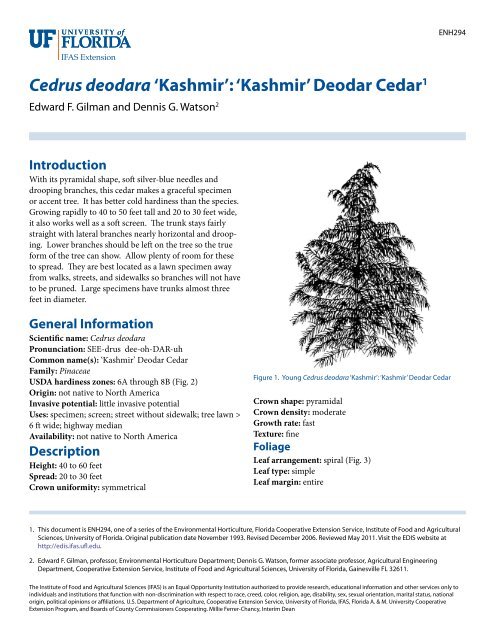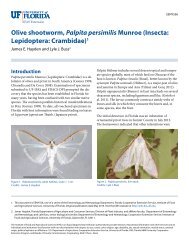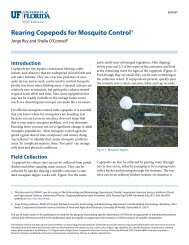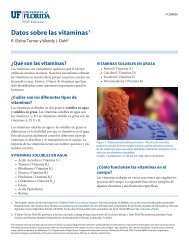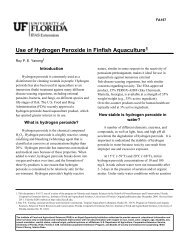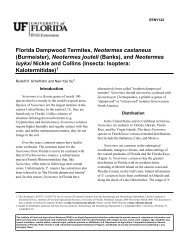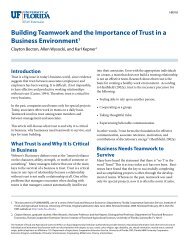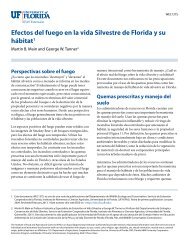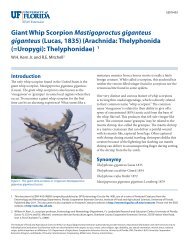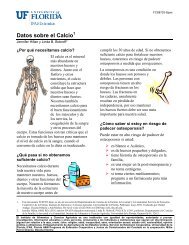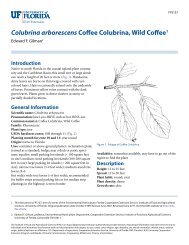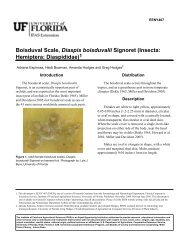Cedrus deodara 'Kashmir': 'Kashmir' Deodar Cedar1 - EDIS ...
Cedrus deodara 'Kashmir': 'Kashmir' Deodar Cedar1 - EDIS ...
Cedrus deodara 'Kashmir': 'Kashmir' Deodar Cedar1 - EDIS ...
You also want an ePaper? Increase the reach of your titles
YUMPU automatically turns print PDFs into web optimized ePapers that Google loves.
<strong>Cedrus</strong> <strong>deodara</strong> ‘Kashmir’: ‘Kashmir’ <strong>Deodar</strong> Cedar 1<br />
Edward F. Gilman and Dennis G. Watson 2<br />
Introduction<br />
With its pyramidal shape, soft silver-blue needles and<br />
drooping branches, this cedar makes a graceful specimen<br />
or accent tree. It has better cold hardiness than the species.<br />
Growing rapidly to 40 to 50 feet tall and 20 to 30 feet wide,<br />
it also works well as a soft screen. The trunk stays fairly<br />
straight with lateral branches nearly horizontal and drooping.<br />
Lower branches should be left on the tree so the true<br />
form of the tree can show. Allow plenty of room for these<br />
to spread. They are best located as a lawn specimen away<br />
from walks, streets, and sidewalks so branches will not have<br />
to be pruned. Large specimens have trunks almost three<br />
feet in diameter.<br />
General Information<br />
Scientific name: <strong>Cedrus</strong> <strong>deodara</strong><br />
Pronunciation: SEE-drus dee-oh-DAR-uh<br />
Common name(s): ‘Kashmir’ <strong>Deodar</strong> Cedar<br />
Family: Pinaceae<br />
USDA hardiness zones: 6A through 8B (Fig. 2)<br />
Origin: not native to North America<br />
Invasive potential: little invasive potential<br />
Uses: specimen; screen; street without sidewalk; tree lawn ><br />
6 ft wide; highway median<br />
Availability: not native to North America<br />
Description<br />
Height: 40 to 60 feet<br />
Spread: 20 to 30 feet<br />
Crown uniformity: symmetrical<br />
ENH294<br />
Figure 1. Young <strong>Cedrus</strong> <strong>deodara</strong> ‘Kashmir’: ‘Kashmir’ <strong>Deodar</strong> Cedar<br />
Crown shape: pyramidal<br />
Crown density: moderate<br />
Growth rate: fast<br />
Texture: fine<br />
Foliage<br />
Leaf arrangement: spiral (Fig. 3)<br />
Leaf type: simple<br />
Leaf margin: entire<br />
1. This document is ENH294, one of a series of the Environmental Horticulture, Florida Cooperative Extension Service, Institute of Food and Agricultural<br />
Sciences, University of Florida. Original publication date November 1993. Revised December 2006. Reviewed May 2011. Visit the <strong>EDIS</strong> website at<br />
http://edis.ifas.ufl.edu.<br />
2. Edward F. Gilman, professor, Environmental Horticulture Department; Dennis G. Watson, former associate professor, Agricultural Engineering<br />
Department, Cooperative Extension Service, Institute of Food and Agricultural Sciences, University of Florida, Gainesville FL 32611.<br />
The Institute of Food and Agricultural Sciences (IFAS) is an Equal Opportunity Institution authorized to provide research, educational information and other services only to<br />
individuals and institutions that function with non-discrimination with respect to race, creed, color, religion, age, disability, sex, sexual orientation, marital status, national<br />
origin, political opinions or affiliations. U.S. Department of Agriculture, Cooperative Extension Service, University of Florida, IFAS, Florida A. & M. University Cooperative<br />
Extension Program, and Boards of County Commissioners Cooperating. Millie Ferrer-Chancy, Interim Dean
Figure 2. Range<br />
Leaf shape: needle-like (filiform)<br />
Leaf venation: parallel<br />
Leaf type and persistence: evergreen, needled evergreen<br />
Leaf blade length: less than 2 inches<br />
Leaf color: silver<br />
Fall color: no color change<br />
Fall characteristic: not showy<br />
Flower<br />
Flower color: unknown<br />
Flower characteristics: not showy<br />
Fruit<br />
Fruit shape: oval, cone<br />
Fruit length: 3 to 6 inches<br />
Fruit covering: dry or hard<br />
Fruit color: brown<br />
Fruit characteristics: does not attract wildlife; showy; fruit/<br />
leaves not a litter problem<br />
Trunk and Branches<br />
Trunk/bark/branches: branches droop; not showy; typically<br />
one trunk; thorns<br />
Pruning requirement: little required<br />
Breakage: resistant<br />
Current year twig color: green, brown<br />
Current year twig thickness: medium<br />
Wood specific gravity: unknown<br />
Culture<br />
Light requirement: full sun<br />
Soil tolerances: sand; loam; clay; acidic; slightly alkaline;<br />
well-drained<br />
Drought tolerance: high<br />
Aerosol salt tolerance: unknown<br />
Other<br />
Roots: not a problem<br />
Winter interest: no<br />
Outstanding tree: yes<br />
Ozone sensitivity: unknown<br />
Verticillium wilt susceptibility: resistant<br />
Pest resistance: resistant to pests/diseases<br />
Figure 3. Foliage<br />
Use and Management<br />
The species has been successfully used as a street or median<br />
planting with lower branches removed. It appears to tolerate<br />
compacted, poor soil but declines in areas where smog<br />
is a problem. Plant on 20-foot-centers to create a canopy of<br />
blue foliage over a small residential street. This is probably<br />
the best true cedar for the South.<br />
Transplants easily if root-pruned or from a container<br />
and protected from sweeping winds. It does well in dry,<br />
sunny spots and will tolerate high pH and clay soil. Colddamaged<br />
trees die back at the top.<br />
There are some other attractive cultivars. `Aurea’ has yellow<br />
leaves (looks ill); `Pendula’ has long, drooping leaves;<br />
`Robusta’ has stiffer twigs.<br />
Pests and Diseases<br />
No pests or diseases are of major concern. Perhaps scales,<br />
borers, deodar weevils, and bagworms. Following a cold<br />
2
winter, tops often decline and dieback. Secondary fungi<br />
can sometimes be associated with this decline.<br />
3


